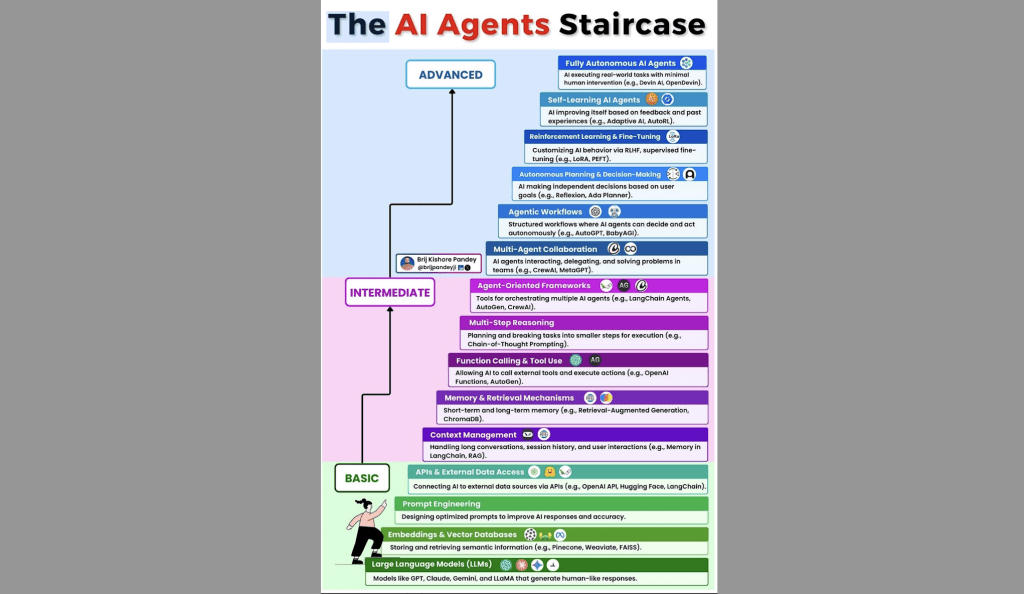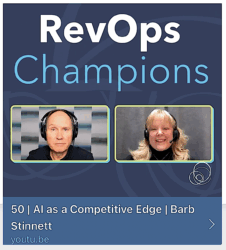We saw a fascinating LinkedIn post the other day, where the diagram we feature here appeared. It was a post by Brij kishore Pandey, who describes himself as a GenAI Architect, Strategist, Innovator, and Keynote Speaker. And we credit him for this diagram.
He says this about it: 𝗧𝗵𝗲 𝗔𝗜 𝗔𝗴𝗲𝗻𝘁𝘀 𝗦𝘁𝗮𝗶𝗿𝗰𝗮𝘀𝗲 represents the 𝘀𝘁𝗿𝘂𝗰𝘁𝘂𝗿𝗲𝗱 𝗲𝘃𝗼𝗹𝘂𝘁𝗶𝗼𝗻 from passive AI models to fully autonomous systems. Each level builds upon the previous, creating a comprehensive framework for understanding how AI capabilities progress from basic to advanced:
– BASIC FOUNDATIONS
– INTERMEDIATE CAPABILITIES
– ADVANCED AUTONOMY
The strategic implications of this evolution are these, he says:
• 𝗖𝗼𝗺𝗽𝗲𝘁𝗶𝘁𝗶𝘃𝗲 𝗗𝗶𝗳𝗳𝗲𝗿𝗲𝗻𝘁𝗶𝗮𝘁𝗶𝗼𝗻: Organizations operating at higher levels gain exponential productivity advantages
• 𝗦𝗸𝗶𝗹𝗹 𝗗𝗲𝘃𝗲𝗹𝗼𝗽𝗺𝗲𝗻𝘁: Engineers need to master each level before effectively implementing more advanced capabilities
• 𝗔𝗽𝗽𝗹𝗶𝗰𝗮𝘁𝗶𝗼𝗻 𝗣𝗼𝘁𝗲𝗻𝘁𝗶𝗮𝗹: Higher levels enable entirely new use cases from autonomous research to complex workflow automation
• 𝗥𝗲𝘀𝗼𝘂𝗿𝗰𝗲 𝗥𝗲𝗾𝘂𝗶𝗿𝗲𝗺𝗲𝗻𝘁𝘀: Advanced autonomy typically demands greater computational resources and engineering expertise
He goes on: The gap between organizations implementing advanced agent architectures versus those using basic LLM capabilities will define market leadership in the coming years. This progression isn’t merely technical—it represents a fundamental shift in how AI delivers business value.
In closing, he asks: where does your approach to AI sit on this staircase?
——————
The above post was certainly informative. It encouraged us to ask one of our AI colleagues and friends if he could expand on it and give us his reaction. Dan McCreary is an author and distinguished engineer with a deep background helping decision makers use AI to increase the productivity of knowledge workers.
“I have a somewhat simpler model in my agents course,” he said. And he provided this link. “But the basic idea of starting off with simple prompt engineering and proceeding to more complex patterns is the same idea,” Dan continued. ”My focus is really moving up the ladder of using agents to store increasingly more precise models of the world in a knowledge graph.” And he provided another link.
“The Staircase Metaphor is useful,” Dan said, “but it implies that to take any step N, you must first get to step N-1. In the real world there are many paths to the top level.”
Dan has developed a “MicroSim” interactive infographic that guides people through the five levels of intelligent textbooks, which is a current project of his. See this link. “A much more precise metaphor is a ‘map’ that shows you the exact path you need to take to reach a goal,“ Dan concluded. “That is called a Learning Graph.”
Dan has developed an extensive and very helpful glossary of terms on the topic of Building Intelligent Agents.
For more about Dan’s work, watch for another blog post to come after this, which will be a summary of an online event we held on March 19 on the topic of AI in the Enterprise, which included a brief presentation by him. In that post, we’ll share a link to Dan’s slides.







